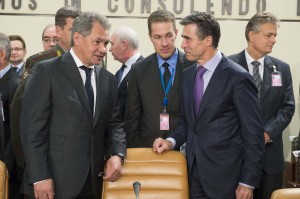 Cooperation between Russia and NATO in the 22 years of existence is a lot like a business-marriage. How long interests coincide, the relationship will find inner resources to overcome any divergence. But when interests no longer coincide, the chances of a compromise quickly tend towards zero. And the crises are felt much larger and require more time to restore the relationship to an acceptable level of cohabitation.
Cooperation between Russia and NATO in the 22 years of existence is a lot like a business-marriage. How long interests coincide, the relationship will find inner resources to overcome any divergence. But when interests no longer coincide, the chances of a compromise quickly tend towards zero. And the crises are felt much larger and require more time to restore the relationship to an acceptable level of cohabitation.
Improving capabilities, progress in Afghanistan and NATO-Russia cooperation was top the agenda of last week’s two-day (22 -23 October 2013) NATO Defence Ministerial meeting. According NATO officials, the Defence Ministers from Alliance’s members countries also discussed about cyber-defence, NATO’s Ballistic Missile Defence system and review NATO reforms and assessed progress made in the over 20 Smart Defence projects launched at the Chicago Summit last year.
Not less significant, in the second day of the Defence ministerial meeting, NATO-Russia Council (NRC) had a new (the first ministerial meeting over two years) session. The Council was created on 28 May 2002 during the NATO Summit in Rome and is focusing on ways to build on the positive military practical and defence cooperation involving “consensus-building, consultations, joint decisions and joint actions”. NATO Defence Ministers together with their Russian counterpart, Sergey Shoygu, discussed ways to widen their practical military cooperation and exchanged views on pressing events on the international agenda, including Syria. Although prior to the meeting the NATO headquarters expressed the confidence that Shoigu’s involvement in the meeting means the unique opportunity to give an impetus to military relations between Russia and NATO in the field of security, at the end of the Council, moderation was the watchword for the views of both sides. Mass-media mainly observed divergences and less positive part. But how it looks in reality cooperation Russia – NATO beyond the headlines? Let’s take a look about…
‘Some pragmatic deals…
As I said previously, NATO and Russia worked together and effectively collaborate on the levels where the interests of the two coincide. And there are some areas of convergence. Cooperation between Russia and NATO now develops in several main sectors: fighting terrorism (including the vulnerability of critical infrastructure), military cooperation, also cooperation on Afghanistan (including transportation by Russia of non-military ISAF freight, and fighting the local drug production and drug trafficking). Also aviation security, cyber-crime, industrial cooperation, non-proliferation are some aspects of this collaboration.
According Secretary General of NATO, Anders Fogh Rasmussen, “stability and security in Afghanistan remain a key priority of Russia – NATO partnership”. Of course, there is a common interest to fight against terrorism and to create a stable Afghanistan for the future. Russia’s interest in Afghanistan is more keenly tied to counter-narcotics, owing to the problems that Afghan-produced drugs are creating in Russia. Conform to a report from the United Nations’ Office on Drugs and Crime (UNODC) on Afghanistan’s opium trade, “There, terrorist groups and insurgents are quick to feed off the illicit trade, with their efforts aided by the immense market in Russia. Russian addicts consume 75 to 80 tons of Afghan heroin each year, and an estimated 30,000 to 40,000 Russians die in drug-related incidents annually”. But also, Russia is concerned about the potential that violent extremists in Afghanistan will go elsewhere when the conflict is over or when NATO pulls out of Afghanistan next year. The NRC is also cooperating on a project to train Afghan helicopter technicians – an excellent example of where NATO-Russia Council nations are combining their efforts to assist the Afghan National Security Forces in developing their capacity to maintain security in the country. Another “bright point” and successful project (in cooperation with UN) to train counter-narcotics officers from Afghanistan, Pakistan and Central Asia – to the Domodedovo Center near Moscow and North-West Training Centre in St. Petersburg where have so far trained over 2,800 counter narcotics officers from Afghanistan, Central Asia and Pakistan. In the same time, US and its allies need Russia support because American relations with Afghan leadership seem to be more problematic and post-Afghan war strategy increasingly devoid of substance and “zero option” as were said American experts, it would repeat the fateful U.S. mistake of abandoning the country following the Soviet withdrawal in 1989, which opened the way to a civil war that brought the Taliban to power and created a haven for al-Qaeda – not to mention President Obama’s repeated public pledges that the United States would continue to stand behind Afghanistan.
Continuing inventory “bright points” can be noted that the NRC conducted “Vigilant Skies 2013“, a live counter-terrorism exercise over the skies of Poland, Russia and Turkey last month involving fighter aircraft, military personnel and command centres from the Arctic to the Black Sea. “The exercise was a great success. We now have a proven joint capacity to respond to the hijacking of civilian aircraft and we have showed how effective the NATO-Russia Council is in this field,” the Secretary General said. It is good to remember that on 6 June 2011, NATO and Russia participated in their first ever joint fighter jet exercise “Vigilant Skies”. Since the Cold War, there were only a few joint military venture between the alliance and Russia – with the first being a joint submarine exercise which begun on 30 May 2011. Then, behold, just recently a NATO ship arrived in port at St. Petersburg as part of continued NATO-Russia Council military cooperation, and provided an opportunity for naval counterparts to meet and exchange experiences. We must to remember also that the Russian Navy’s Udaloy I class anti-submarine destroyer Severomorsk was part in a NATO anti-piracy exercise in the Gulf of Aden.
Speaking about military cooperation between Russia and NATO in 2014, at the recent meeting in Brussels, Russia Defence Minister Shoigu said that “in the next few months the two sides would set up a trust fund for the utilization of outdated Russian ammunition”. Also the Council representatives discussed plans to dispose of excess and unsafe ammunition in Russia. “I expect that we will be able to finalise the details and launch a new trust fund to support the project in the coming months,” said Mr. Fogh Rasmussen.
Last but not least “bright point”, NATO and Russia are also working together to develop technology to detect explosives in public spaces such as airports, subways and train stations. This year the NRC took a big step forward in the area by testing the technology in real-life conditions. Next year, NATO and Russia will test jointly developed technology to detect explosives in crowded places. General Secretary of NATO, Rasmussen said that the test would be carried out in a metro station in a European capital. More exactly, he has spoken about the Standex project to help identify low-capacity bombs carried by suicide bombers. The tests should establish whether Standex can not only identify the presence of explosives in the crowd but also pinpoint the bomber’s exact location.
…is unlikely to develop into lasting love’
In spite of recent positive developments of NATO-Russia’s business-marriage, there remain multiple shadows. For example, the West never forgot to remember about military intervention in Georgia. In reply, Russia continues to look with suspicion to NATO’s open door policy toward Georgia and Ukraine, believes a new security architecture for Europe is needed to replace the outdated NATO model (notice: Russia’s ex-president Medvedev in November 2009 proposal for a new European Security not provided sufficient adhesion even among the European countries members of NATO). And the resumption of discussion on this topic will create new reasons for irritation.
On the list of “mismatches” between Russia and NATO, missile shield location holds a special place. Is the “red line” beyond which if it passes, Russia threatens with a thunderous divorce. It is the preferred reason invoked whenever Russia feels restricting its sphere of influence. The main argument put forward – NATO missile shield is designed to reduce the deterrent effect of Moscow’s arsenal and thus alter the balance of power on the continent. And in this respect recent meeting of Russian Defence Minister Shoigu and his his counterparts from North-Atlantic Alliance change nothing. Regarding cooperation on missile defence, the Secretary General of NATO said that “it is no secret that we have not yet found the way to work together” in this area. “However, ministerial discussions are valuable in addressing existing concerns and we need to continue to engage frankly and directly to overcome our differences.” More, Rasmussen announced that “as a next step in our US-led missile defense in Europe, a groundbreaking ceremony for the land-based Aegis system will take place in Romania by the end of October”. Russian Defence Minister Sergei Shoigu did not hesitate to express diplomatic and honest the way things actually. “Collaboration in this area is impossible. The missile defense program of the USA in Europe develops, and our concerns aren’t considered” Shoigu told in a press conference after the meeting. “Before studying missile defense projects, we want to have assurances that this US missile defense system is not against Russia” he said adding that Moscow “does not have enough predictability regarding the US and NATO missile defense plans.” Course, admitting that the Russian concern has an understandable basis in principle ( if U.S. missile defenses continue to grow in numbers and quality, at some future point they could undermine the balance in strategic offensive forces between Russia and the United States), its request about legal guarantees is just a rhetorical claim. Even if the Obama administration would be prepared to negotiate a legal guarantee, there is no possibility of securing the two-thirds majority in the Senate needed for consent to ratification of a treaty. Russia and NATO initially agreed to cooperate on the so-called European missile defense system at the Lisbon summit in November 2010. But NATO insists there should be two independent systems that exchange information, while Russia favors a joint system with full-scale interoperability. And I think here one can still find the key to a compromise.
Cooperation and transparency – fundamental attributes of the future international relations
As agreed at the NATO-Russia Council meeting to the level of Chiefs of Staff session from January 2013, NATO and Russian Military Authorities implemented a common secure line of communication between their offices to strengthen their relationship and bring military-to-military cooperation to a new level of trust and transparency. The opening of secure line was held in February 2013, when General Knud Bartels, Chairman of NATO’s Military Committee and Chairman of the NRC Military Representatives, initiated an historical phone call with Colonel-General Valeriy Gerasimov, Chief of the General Staff of the Armed Forces of the Russian Federation.
The recent NATO – Russia Council ministerial meeting also try to find ways to increase transparency on military exercises and international security issues, in particular in the Middle East, including Syria. “We plan to continue such transparency measures in the future” Rasmussen said. Defense Minister Sergey Shoigu told journalists in Brussels after the meeting of the NATO-Russia Council that his country had received an invitation to the exercises and that Russia’s Defense Ministry will send a delegation to NATO military exercises in November. The North Atlantic alliance has announced that the exercises, named Steadfast Jazz 2013, will be held on November 2 to 9 in Poland and Baltic states. The exercise scenario envisions a military clash, partial occupation of a territory and restoration of the country’s territorial integrity. Notice that to the recent series of Russian-Belarusian drills, entitled Zapad (West) 2013, were attended by more than 80 military attaches, also from NATO. It is sufficiently? Probably is not. But, right, it is an important way to improve the trust between parts.
In the context of global challenges, cooperation and transparency – must to become the fundamental attributes of the international relations. And way in which is structured the relationship between Russia and NATO can act like a pattern. Especially since the West seems more open to cooperation with all major global players, not just with Russia. Recall that the 2012 RIMPAC drills, hold between July 11 and August 1, involved 45 warships and support vessels from 22 countries, as well as 100 combat aircraft and over 20,000 naval sailors, including for first time the Russian task force, represented by the destroyer Admiral Panteleyev, the tanker Boris Butoma and the salvage tug Fotiy Krylov. And the next iteration of the biannual Rim of the Pacific military exercises – 2014 could include for first time China’s navy.
Withal, beyond divergent views between Russia and the West and in special the US, all parts appear to have understood that, as Henry Kissinger said in a long time ago – the lifting of China and Asia – in the coming decades will a substantial shift of the international system, the center of gravity will moves from the Atlantic to the Pacific. And the development of many international relations will depend on how each will require its interests in Pacific area.
So far, the relationship between Russia and NATO seems to contradict the opinion of sociologists and relationship experts which claim within ten years those who had a business-marriage will have a stronger relationship. After 22 years since the beginning this relationship is just a little over Cold War temperature. It should be pointed out that in this case such business-marriages does not work because the social and cultural profile of marriage is seen differently by each part. And, perhaps most important – no matter how pragmatic can be somebody in choosing a partner, there always needs “to be chemistry”.









